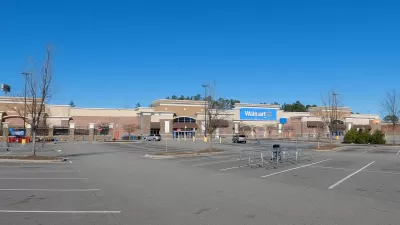For years, the sizes of grocery stores have grown increasingly to provide a greater variety to the consumer. Andrew Martin explains why retailers have now begun opening smaller stores instead.
"The idea is to lure time-starved shoppers who want to pick up a few items or a fast meal without wandering long grocery aisles or paying restaurant prices."
"The opening of smaller stores upends a long-running trend in the grocery business: building ever-larger stores in the belief that consumers want choice above all. While the largest traditional grocery stores tend to be about 85,000 square feet, some cavernous warehouse-style stores and supercenters are two or three times that size.
Statistics compiled by the Food Marketing Institute show that the average size of a grocery store dipped slightly in 2007 - to a median of 47,500 square feet - after 20 years of steady growth."
FULL STORY: Miles of Aisles for Milk? Not Here

Alabama: Trump Terminates Settlements for Black Communities Harmed By Raw Sewage
Trump deemed the landmark civil rights agreement “illegal DEI and environmental justice policy.”

Planetizen Federal Action Tracker
A weekly monitor of how Trump’s orders and actions are impacting planners and planning in America.

The 120 Year Old Tiny Home Villages That Sheltered San Francisco’s Earthquake Refugees
More than a century ago, San Francisco mobilized to house thousands of residents displaced by the 1906 earthquake. Could their strategy offer a model for the present?

Indy Neighborhood Group Builds Temporary Multi-Use Path
Community members, aided in part by funding from the city, repurposed a vehicle lane to create a protected bike and pedestrian path for the summer season.

Congestion Pricing Drops Holland Tunnel Delays by 65 Percent
New York City’s contentious tolling program has yielded improved traffic and roughly $100 million in revenue for the MTA.

In Both Crashes and Crime, Public Transportation is Far Safer than Driving
Contrary to popular assumptions, public transportation has far lower crash and crime rates than automobile travel. For safer communities, improve and encourage transit travel.
Urban Design for Planners 1: Software Tools
This six-course series explores essential urban design concepts using open source software and equips planners with the tools they need to participate fully in the urban design process.
Planning for Universal Design
Learn the tools for implementing Universal Design in planning regulations.
Clanton & Associates, Inc.
Jessamine County Fiscal Court
Institute for Housing and Urban Development Studies (IHS)
City of Grandview
Harvard GSD Executive Education
Toledo-Lucas County Plan Commissions
Salt Lake City
NYU Wagner Graduate School of Public Service





























